Super smooth and creamy matcha cheesecake with a sweet blueberry swirl. This easy cheesecake is baked in a gluten-free graham cracker crust with no water bath!
It's high time I posted a baked gluten-free cheesecake on this site! This matcha cheesecake, with its slight grassy notes and bright floral blueberries, feels just right for spring and summer. But with a green and purple contrast, feels equally suited for Halloween as a spooky treat - maybe Elphaba Wicked Cheesecake?
A few weeks ago, Ira (2) FaceTimed my dad. He set him up on the bench and performed an original song and when he finished, he said to himself, “Whew - that was a good song!” I admire his confidence.
I think I muttered almost the same thing about this gluten-free matcha cheesecake with blueberry swirl. Whew - that is a good cheesecake! Sometimes things are so good, you've gotta pat yourself on the back a bit.
What does matcha cheesecake taste like?
Matcha is the star of this cheesecake, with an umami-sweet flavor that's a bit nutty and vegetal. Paired with tangy cream cheese, this tastes remarkably like a sweet matcha latte.
The jammy blueberry swirl offers a brightness that balances the slight grassy notes from matcha.
All about Matcha
For the most vibrant green color and best flavor, I recommend using high-quality matcha for this cheesecake. I use Encha Organic Latte Grade, which I love because it's bright green and has a complex flavor profile. You can read all about matcha and picking the best one over on my ultimate guide to matcha.
This recipe calls for 2 tablespoons of matcha in this cheesecake, which makes it the main flavor star, but for a more subtle matcha flavor, reduce it to just 1 tablespoon. This recipe has you mix the matcha with some reserved sugar before adding it, which will keep the matcha powder from clumping.
I urge everyone who says they're not a matcha fan to give it another try with high-quality Japanese matcha. Made with quality matcha, even my 2-year-old loves this matcha cheesecake. That being said, you could also leave the matcha out entirely and it'll bake up like a classic cheesecake swirled with blueberries.
No-bake versus baked cheesecake
In my book, no-bake cheesecake and baked cheesecake are two completely separate desserts, alike only in that they use cream cheese.
No-bake cheesecake is more velvety. It's usually folded with whipped cream into a light and airy mousse. It's refreshing and super easy to make, especially when it's too hot to turn on the oven for an hour. Here's my recipe for gluten-free no-bake matcha cheesecake. In that version, I topped it with a black sesame icing to make little Frankensteins, but you can just leave it plain as bars, adding a berry compote for serving if you like!
Baked cheesecake, on the other hand, has a more classic flavor and texture. It's got a creamy silky smooth filling that's a bit denser. It slices more like a traditional cake and offers a more complex and richer flavor profile. That's what this gluten-free matcha cheesecake is here.
How to make a gluten-free graham cracker crust
The gluten-free graham cracker crust for this matcha cheesecake is super easy. This is one of the easiest pie crusts to make! Here's my go-to gluten-free graham cracker crust that I've used as the base for this cheesecake.
For a cheesecake graham cracker crust:
- Mix together the crushed graham crackers, sugar, salt, and melted butter.
- Press and bake the crust in a 9-inch springform pan and let it cool.
- Fill the crust and bake until the cheesecake is set. The springform pan makes it easy to release and slice the cheesecake cleanly.
For a cheesecake, press the edge about ¾-inch to 1-inch up the side of the pan. Leave the edge shaggy or use a thin knife along the top to create a more evenly straight edge.
When you fill the crust, the filling may "overflow" the crust just a bit and that's okay! Once baked, the filling will pull away from the sides slightly. Having the crust edge lower than or just even to the top of the cheesecake makes it much easier to cut the cheesecake after it's baked without the crust breaking off.
How to make baked matcha cheesecake
If this matcha blueberry swirl cheesecake seems complicated and scary, rest assured, this recipe is even easier than baking a birthday cake.
- Make the compote and let it cool.
- Make the crust and let it cool.
- Beat the cream cheese and sugar together.
- Mix in the sour cream, vanilla, and salt, followed by the matcha sugar, and mix until smooth.
- Carefully add the eggs, until just combined.
- Pour into cooled crust and swirl in the compote.
- Bake on the middle rack with a baking pan of boiling water on the bottom rack.
- Let cool in the oven.
- Chill overnight.
How to make swirls in a cheesecake
To make deep vibrant purple blueberry swirls in the green matcha cheesecake, make a quick stovetop blueberry compote. Purée half of the compote, saving the other half for serving. This compote is rich in color and flavor, so it stands out both visually and when you take a bite.
Dollop ¼ - ½ teaspoon drops all over the smoothed surface of the cheesecake, as pictured above, then use a chopstick, knife, or toothpick, sticking it in about ½-inch to swirl the compote on the surface of the cheesecake, as desired.
If you want to avoid the swirl to keep things simple, you can just make the compote, skip the blending and swirling, and serve it spooned on top of the fully baked cheesecake.
Tips for baking a perfect cheesecake
Use room temperature ingredients to avoid lumps
One of the keys to a perfect cheesecake that doesn't crack when baking or cooling is to avoid overmixing the batter. For that reason, it's extra important to use room temperature ingredients, because they more easily mix together.
Additionally, cold cream cheese is more prone to clumping, which, in a green matcha cheesecake, would be particularly noticeable. If your room temperature is cooler than 70 degrees, I recommend slicing the cream cheese, laying it flat on a plate, and zapping it for 8-10 seconds in the microwave to soften it so it's creamy and easy to blend.
Scrape Down the Sides
Like a broken record, I mention scraping down the sides of the bowl while mixing. I do this instinctively with all my baking, but it's especially important with a cheesecake, for which you don't want to overmix your ingredients.
Scraping down the sides helps ensure there are no lumps or clumps of ingredients and allows you to mix thoroughly without having to beat the batter for a long time.
Do not overmix the eggs
As soon as you add the eggs, take care to just mix the batter until combined. If you overmix the eggs into the batter, you'll risk incorporating too much air into the batter, which will make it more likely to puff up quickly and then crack when baked or cooling.
Skip the water bath and use a pan of water to create steam
Steam will help the cheesecake rise evenly and slowly, further reducing the risk of cracks in the top. However, you can still achieve this without a proper water bath. With this method, you don't need to wrap the springform pan in foil and risk water seeping into the crust.
Simply prepare a steaming pan by boiling about 2-quarts of water. Place 9x13 baking dish on the bottom rack of the preheated oven. Place the cheesecake on the middle rack of the oven and pour the boiling water into the 9x13 pan on the bottom rack. Then quickly close the oven door, trapping in the steam.
Let cool in the oven with door open for an hour
Another common cause of cracking is if the cheesecake changes temperatures too quickly. To avoid this, turn off the oven and open the door a few inches. Let the oven and the cheesecake cool slowly together for an hour before transferring the cheesecake to the fridge.
Chill overnight
It's so tempting to want to slice into your cake when you pull it out of the oven, but a cheesecake isn't done yet. If you try slicing it after it's just cooled, you'll end up with a soft goopy pudding.
Instead, the final step comes from chilling it for at least 6 hours or overnight. This allows the cheesecake to set-up until firm.
How to tell when cheesecake is done
Telling whether a cheesecake is done seems like one of the most complicated parts of making a cheesecake. And the answer depends on how you like your cheesecake. I recommend baking this cheesecake for 50-60 minutes, checking for doneness around 45 minutes, to account for oven variation.
If you like it creamier and silkier, bake it toward the lower end of the range. A creamy fully-baked cheesecake still holds its shape when sliced, but cuts almost like a smooth ganache against your fork.
On the contrary, if you prefer it just a more firm so it sort of breaks when cut with a fork, bake it for a little longer.
If you tap the pan and the cheesecake ripples or sloshes, bake it longer. The entire cheesecake should jiggle as one piece almost like Jell-O. There should be an outer ring around the edge that is just ever so slightly more set, while the center wobbles more.
Can I freeze this matcha cheesecake
Yes! You can absolutely freeze this matcha cheesecake. First let the cheesecake set for 6 hours or overnight in the fridge.
Then, either leave it whole or slice it up to freeze for up to 2 months. To keep it looking smooth and pretty, I recommend placing the whole or sliced cheesecake in the freezer for a couple of hours uncovered before wrapping the entire thing well in plastic wrap and then foil. Alternatively, if the slices fit, transfer them to an air-tight container.
Let it thaw at room temperature for a few hours or in the fridge overnight before serving.
More Matcha Recipes
It's no secret matcha is one of my favorite ingredients. Here are some more matcha recipes!
Matcha Macarons with Mango Buttercream
Gluten-Free Olive Oil Matcha Cake
Recipe
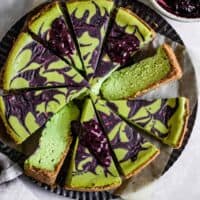
Matcha Cheesecake with Blueberry Swirl
Ingredients
- 1 9-inch gluten-free graham cracker crust in a springform pan, baked and cooled
- 24 ounces (3 8-ounce blocks) full-fat cream cheese (blocked), room temperature, see notes
- ¾ cup + 2 tablespoons (182 g) granulated sugar, divided
- ¾ cup (180 g) sour cream, room temperature
- 1½ teaspoons pure vanilla extract
- ¼ teaspoon kosher salt
- 2 tablespoons high-quality matcha powder
- 2 large eggs, room temperature
- 2 cups fresh or frozen blueberries
- 2 tablespoons granulated sugar
- 1½ tablespoons fresh lemon juice
- 1 tablespoon water
- 1½ teaspoons cornstarch
INSTRUCTIONS
- Preheat the oven to 350°F and bake and cool the gluten-free graham cracker crust in a 9-inch springform pan according to this post (once the pan is cool to the touch, you can speed up cooling the crust by placing it in the fridge). Keep the oven on.
- Prepare the blueberry swirl. In a small saucepan, toss the blueberries, granulated sugar, and lemon juice together and cook, stirring occasionally, over medium heat until the blueberries begin to break down and release their juices, 3-5 minutes. Meanwhile, whisk the water and cornstarch together in a small bowl with a fork, creating a slurry. Slowly pour the corn starch slurry into the blueberries, stirring as you pour. Cook for 1-2 minutes longer until the syrup begins to thicken. Remove from heat and pour half of the sauce into a blender or food processor and blend until smooth. Pour into a bowl and chill until no longer warm (speed this up in the freezer, stirring every couple of minutes). Transfer the remaining chunky sauce to a small bowl and chill until ready to serve.
- Beat the cream cheese and ¾ cup of the granulated sugar over medium-high speed in the bowl of a stand mixer or a large bowl with a hand mixer, until smooth and creamy, scraping down the sides a few times. Add the sour cream, vanilla, and salt, and beat on medium speed combined, scraping down the sides again.
- Mix the remaining 2 tablespoons of sugar with the matcha powder very well, then add it to the filling, mixing on medium speed until just evenly combined, scraping down the sides a couple of times. Add the eggs, one at a time, mixing on medium speed until just combined, scraping down the sides after each addition. Be careful not to overmix the filling after you've added the eggs or you will incorporate too much air into the cheesecake, leading to potential cracks.
- Pour the filling into the cooled crust, give it a couple of taps on the counter to release any air bubbles, then use an offset spatula to smooth the top. Use a small spoon to dollop 3 tablespoons of the blueberry purée in random drops over the top of the cheesecake. Use a chopstick, knife, or toothpick to swirl the blueberry purée into the top of the cheesecake, as pictured above. Mix any remaining purée back into the chunky blueberry compote.
- Prepare a steaming pan by boiling about 2-quarts of water. Place 9x13 baking dish on the bottom rack of the preheated oven. Place the cheesecake on the middle rack of the oven and pour the boiling water into the 9x13 pan on the bottom rack. Quickly close the oven and bake for 50-60 minutes, checking for doneness around 45 minutes, to account for oven variation. See notes below on how to tell when it's done.
- When it's done baking, turn off the oven and open the door a few inches. Let the cheesecake cool in the oven for an hour. Then transfer the cheesecake to the fridge to chill for at least 6 hours or overnight.
- Use a thin knife around the outside edge to ensure the cheesecake is loosened from the pan, then release it from the springform pan. Use a clean sharp knife to cut the cheesecake into slices. To make clean slices, I recommend wiping off the knife, then placing it in warm water, and wiping dry before each cut.
- Serve slices chilled topped with remaining blueberry compote. Store any leftovers covered in the fridge for up to 5 days or in the freezer for up to 2 months.








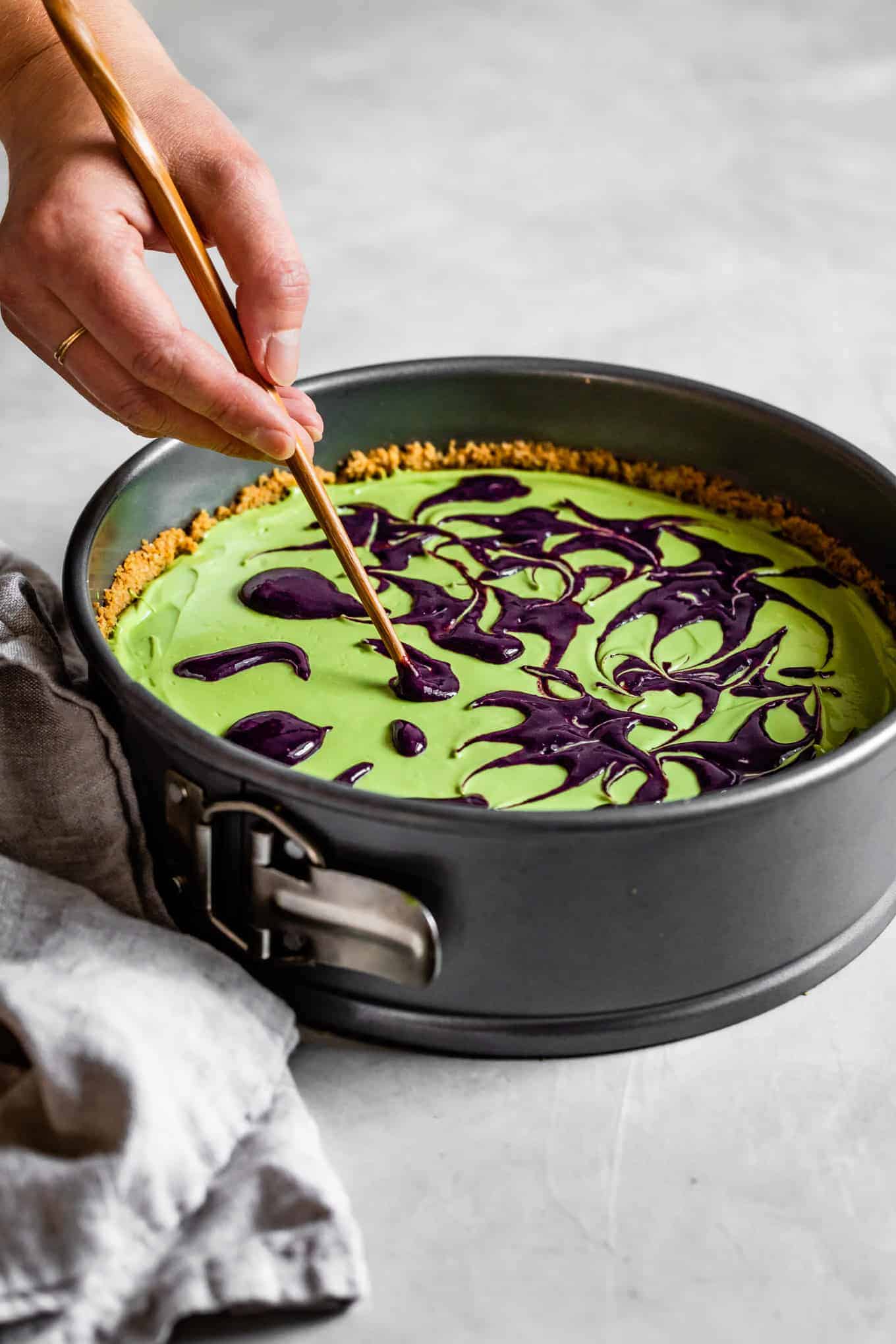
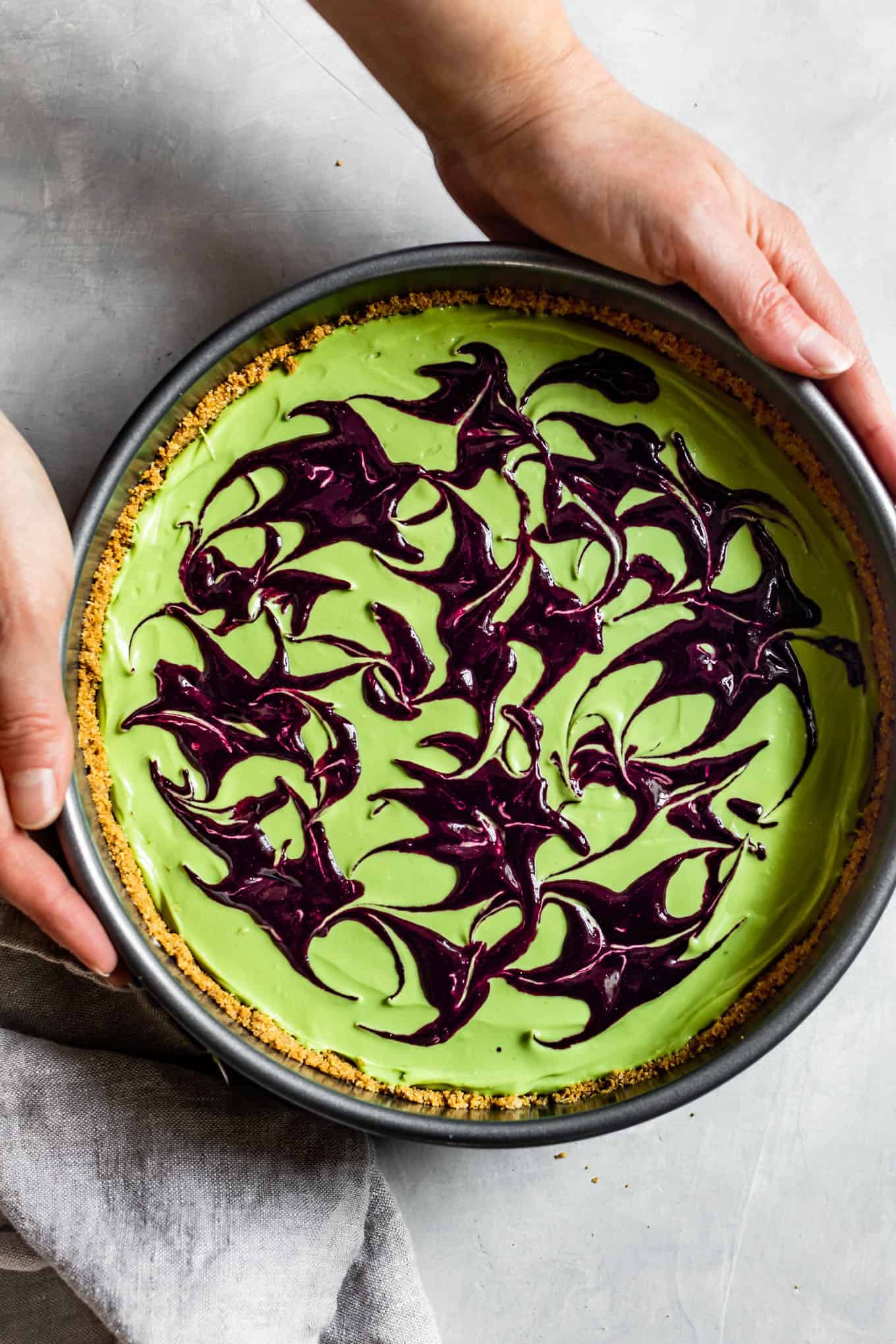









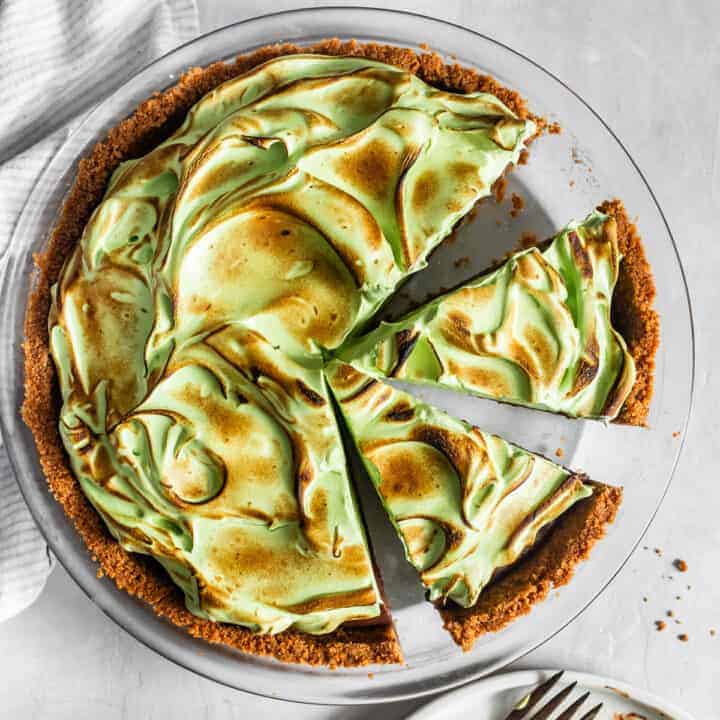
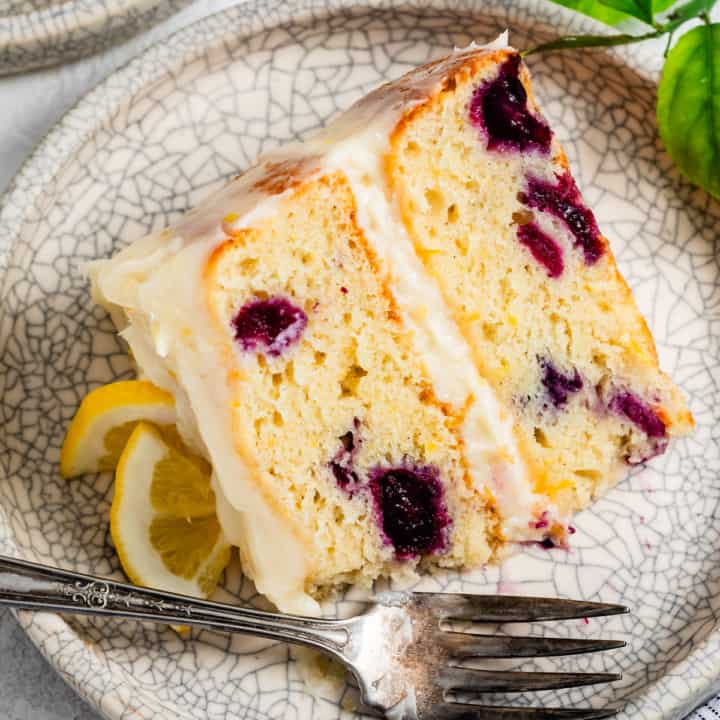

mercmakesfood -
I’m officially hooked on matcha! Even AK loved this cheesecake and he’s not a matcha fan. Planning to make it a yearly Halloween cheesecake tradition 🤣
Scarlett Nguyen -
I followed same the recipe. But my cheesecake came out with very dark matcha color. Not bright as yours! Does any body know reasons? Thank you!
Sarah @ Snixy Kitchen -
Hi! It most likely has to do with the specific matcha powder that you used. What brand of matcha did you use and was the matcha powder bright green (versus dark or muddy green) before adding it to the cheesecake? I use a high quality matcha (Encha latte grade) which starts out bright green and keeps my desserts also bright green.
Lavonne -
Hello, is it possible to substitute raspberries or strawberries for the blueberries?
Sarah Menanix -
Yes! Here's a variation I made for California Strawberries that uses strawberries for the swirl.
Carolyn -
So beautiful! I am trying this soon (matcha + blueberries). Have you ever tried the matcha version with your strawberry swirl? I'm thinking that if the flavors blend, it'd be a lovely green/red for Christmas.
Sarah @ Snixy Kitchen -
Yes! Matcha and strawberry also go really well together!
Xinnia -
Hello, this looks super delicious I would like to make it this week.
Just one question, do you use parchment paper at the bottom of the crust?
or how you move it from the tin onto a plate?
Sarah Menanix -
I don't use parchment paper, but the crust has enough butter that if you run an offset spatula or thin knife under it, it'll pop off the springform bottom!